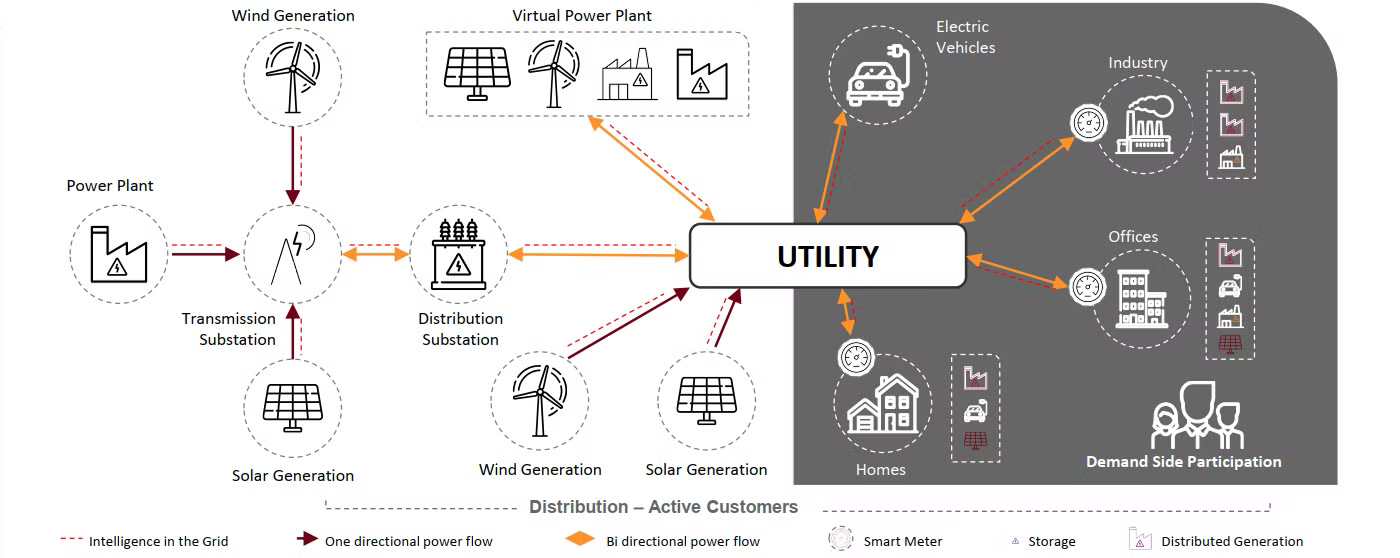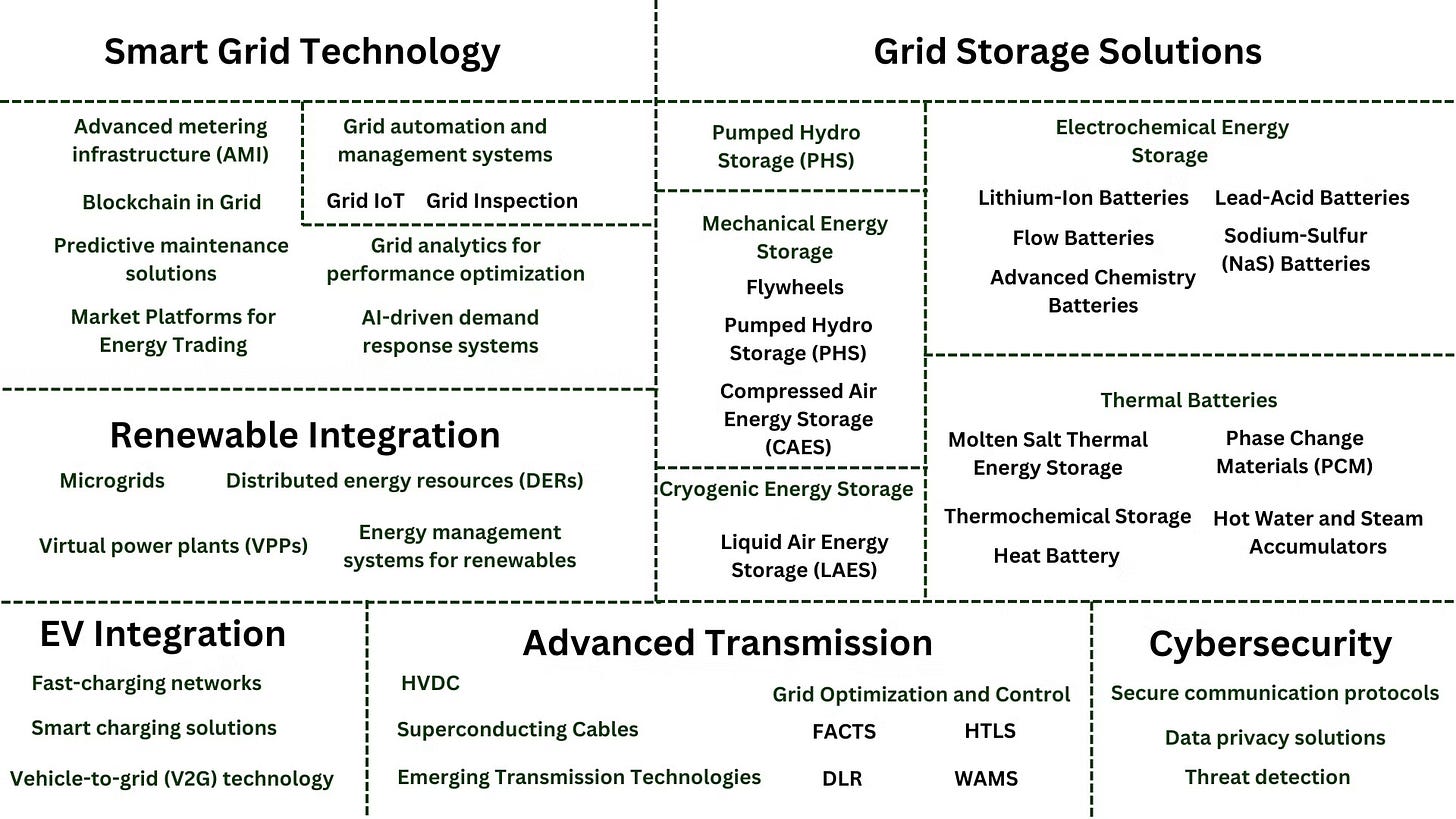Powering the Future: Innovations in Grid Infrastructure Technology
Exploring Cutting-Edge Solutions for a Sustainable and Resilient Energy Grid
Introduction
The world of grid infrastructure technologies is experiencing a seismic shift towards greater efficiency, reliability, and sustainability. This dynamic sector is a hotbed of innovation, playing a critical role in the transformation of electrical grids to accommodate the increasing integration of renewable energy sources and the growing demand for smarter energy solutions. This blog delves into the key trends, technological advancements, and regulatory incentives shaping the future of grid infrastructure, highlighting leading startups and their groundbreaking work in this vibrant industry.
Figure 1: Grid Infrastructure Value Chain [1]
PESTLE Analysis: Grid Infrastructure Technologies
Regulatory Incentives
Benefits and Challenges of Grid Infra Tech
Grid Infrastructure Technologies
The grid startup sector is an exciting and rapidly evolving field focused on modernizing and improving the efficiency, reliability, and sustainability of electrical grids. Key trends and areas of focus within this sector include:
Figure 4: Grid Infrastructure Tech Mapping by Clarice Qiu
1. Smart Grid Technology
2. Grid Storage Solutions
3. Renewable Integration
4. Electric Vehicle (EV) Integration
5. Cybersecurity
6. Advanced Transmission Technologies
Key Insights and Conclusion
1. Grid Infrastructure Modernization is Critical for Renewable Integration and Resilience:
Advanced grid technologies, such as smart grids, advanced transmission systems (e.g., HVDC), and energy storage, are essential for integrating renewables. These solutions could increase grid capacity by 20-100 GW, potentially saving $5-35 billion in transmission and distribution infrastructure costs over five years. Enhanced grid reliability is crucial as electricity demand is expected to rise by 91 GW over the next decade, driven by electrification and data center growth.
Accelerating grid modernization involves improving the rate of project reviews from the Loan Program Office, and expediting federal permitting processes. Ten NIETC designations [22] are currently assigned where DOE has determined the lack of adequate transmission harms consumers. Typically, grid projects take 3-5 years to deploy, and although the grid is utilized around 50% of the time, planning for peak demand and full optimization is necessary. Achieving this transformation is essential for enhancing grid resilience, reducing costs, and enabling the seamless integration of renewable energy sources.
Figure 23: Deploying advanced grid solutions available can cost effectively increase the capacity of the existing grid to support 20-100 GW of incremental peak demand
2. Virtual Power Plants (VPPs) and Distributed Energy Resources (DERs) are Key to Decentralized Energy Management
Deploying 80-160 GW of VPPs by 2030 can manage 10-20% of peak demand and save $10 billion annually in grid costs. VPPs, with distributed energy resources (DERs) like EV chargers and smart thermostats, provide cost-effective grid management, delivering 40-60% lower costs than traditional solutions. The grid is anticipated to gain 20-90 GW from EV infrastructure and 300-540 GWh from EV storage annually, plus an additional 5-6 GW from DERs between 2025 and 2030.
3. Advanced Technologies Drive Efficiency, Security, and Innovation in the Energy Sector
New technologies such as AI, IoT, and blockchain enhance real-time grid monitoring and predictive maintenance. Dynamic Line Rating (DLR) and Advanced Power Flow Control (APFC) can increase transmission utilization by 10-50%. Cybersecurity measures are critical as grids become more digitized, requiring innovative approaches to protect critical infrastructure.
4. The Role of LDES in Achieving Net-Zero Energy Goals
Long Duration Energy Storage (LDES) is critical for the U.S. to achieve a net-zero economy by 2050, requiring 225-460 GW of capacity and an estimated $330 billion in cumulative capital investment. LDES can provide significant grid flexibility, reliability, and resilience, potentially saving $10-20 billion annually in operating costs compared to scenarios without LDES. To be competitive with alternative storage technologies, LDES must reduce costs by 45-55% and improve efficiency by 2030, while achieving a manufacturing and deployment scale-up to 10-15 GW annually by 2035. Achieving these milestones would position LDES as a key solution to decarbonize the grid, reduce reliance on natural gas peakers, and support high renewable energy penetration.
5. Maximizing Energy Affordability and Equity through LDES, VPPs, and Advanced Grid Solutions
Nearly 20 million U.S. households were behind on electric bills as of early 2023, highlighting energy affordability challenges. Deploying Long Duration Energy Storage (LDES), Virtual Power Plants (VPPs), and advanced grid solutions like smart grids and automated demand response can provide affordable, reliable, and resilient energy options. LDES alone could reduce grid costs by $10-20 billion annually by 2050 by minimizing renewable curtailment and avoiding new peaker plants. Combined with VPPs and other technologies, these solutions can further lower energy costs, offering significant financial relief and enhancing energy justice for disadvantaged communities.
Figure 24: Grid Infrastructure Tech Mapping by Clarice Qiu







